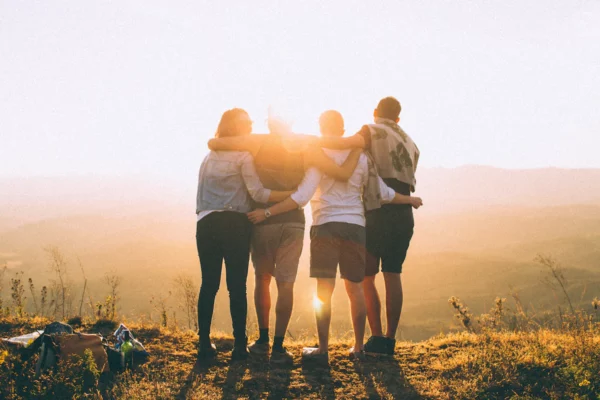
5 Ways We Can Help Save Rainforests and the World Every Day

Rainforests are crucial for the survival of the planet and life on Earth, they pull carbon dioxide out of the air and release oxygen, making the air we breathe cleaner.
Recent research has shown that forests do more than just storing carbon, they also help keep the world at least half a degree cooler making the preservation of forests crucial in the race to prevent global warming going above 1.5 degrees. Forests also provide habitat for 80 percent of the world’s biodiversity, and are the source of 1.6 billion people’s livelihoods.
However, according to the Food and Agriculture Organization of the United Nations (FAO), the global rate of deforestation is about 10 million hectares per year. In the last forty years, that amounts to an area the size of Europe.
The pandemic showed us that carbon emissions can be reduced if we change our lifestyles. Worldwide restrictions caused by Covid-19 meant that in 2020 global emissions fell by 7%. In 2021 they rebounded by 6%.
If we want to save the rainforest, then we have to remake our world, and that means also taking individual actions that can add up to a collective impact. Let’s take a look at some of the things we can change right away.
Here are five ways you can help:
1. Prevent global deforestation!
Deforestation, through conversion of land for other uses, such as agriculture has accelerated the current climate crisis. Forest degradation, through unsustainable harvesting, mining and infrastructures, is also a large contributor. In the Amazon for example, forest degradation is outpacing full deforestation. It has also multiplied the likelihood of both forest fires and traditional burning cycles spinning quickly out of control. Rising temperatures and extreme heat dry out ecosystems to the point of extreme vulnerability.
Show political and industry leaders that failing to tackle deforestation and forest degradation will negatively impact their popularity. You can vote for local, regional and national governments that support environmentally sound and economically viable practices. Alternatively, sign petitions to put pressure on food brands to do their due diligence on their supply chains and check where the ingredients are sourced in your favourite grocery items to ensure they’re not linked to deforestation. When buying a product or ingredient potentially linked to tropical deforestation (beef, soy, palm oil or cocoa for instance), or forest degradation (wood, paper-based products) choose certified products. Certification can be a powerful tool alongside other interventions to help ensure brands have taken into account the impact of their sourcing operations on the environment. In particular, look out for deforestation-free pledges from recognised accreditation organisations.
Consumers should look for products that have a certification, such as the Rainforest Alliance’s little green frog. This seal is an indicator for consumers that farmers and companies have taken steps to make the product in their hands more sustainable, creating a better future for people and nature.
2. Watch what you eat
Cattle ranching and soy production for animal feed contribute the most to commodity-driven deforestation.
Increasing the number of plant-based meals you eat will really help you to slash your carbon footprint.
A study carried out by Oxford University found that meat-based diets account for almost twice as many dietary greenhouse gas emissions per day as vegetarian-based diets. Which is about 2.5 times as many emissions as vegan diets.
One of the worst culprits is beef, the meat with the largest environmental impact. When compared globally, beef accounts for about 65% of all livestock sector emissions. Brazil is the world’s largest beef exporter and illegal cattle ranching in the Amazon has increased deforestation there, in one of the world’s most important ecosystems. The production of soy for livestock feed also causes significant deforestation globally.
You don’t have to suddenly become a vegetarian to help reduce your impact, why not start small with no-meat Mondays, or trying recipes from different cultures that don’t rely so much on meat?
3. Take the train
A simple way you can reduce your emissions is by avoiding air travel where possible. Whilst this is difficult to do with long haul trips, there’s often a train alternative for short haul trips.
On average, travelling by train produces less emissions than flying. For long haul flights, carbon emissions per passenger per kilometre travelled are about three times higher for business class and four times higher for first class, according to the Department for Business, Energy and Industrial Strategy (BEIS). That is why some countries are even making it illegal in some cases to use planes where there is a train alternative. France was the first country to do this, banning domestic flights on routes that can be covered by train in under two and a half hours.
4. Reduce waste and recycle!
TV programmes such as Blue Planet showed us the damage wreaked by plastic pollution. Recycling our used products can help ensure that they are reused and not dumped. Applying pressure to ensure that the UK recycles its waste and doesn’t end up exporting it to other countries will also help make our planet cleaner.
Food waste is also a cause for concern. For example, UK households are responsible for 6.6 Million Tonnes of food waste every year and by weight it makes up 70% of the total food waste in the UK. This means that all the energy, water usage and products used to grow that food have also been wasted, and that land –use, and potentially deforestation, was increased to meet the population’s needs. Getting into the habit of not buying more food than you need, freezing food before it goes off, and composting food waste are clever ways of reducing your impact on the planet.
Reducing waste helps us to live in a more circular economy, which in turns helps us to limit our environmental impact. Instead of wasting energy in food production, we can reduce our emissions. Instead of extracting new materials and using more land, we can recycle those that have already been extracted.
5. Sign up to the Rainforest Alliance’s 30-day challenge
For more easy ideas on how you can make a difference, why not sign up for the Rainforest Alliance’s 30-Day Challenge? You’ll receive lots of tips to inspire you to make more environmentally conscious decisions by adjusting your daily habits. Tips range from conserving water, switching to a plant-rich diet to choosing alternative energy sources like wind and solar as well as reducing your energy consumption. For example, by switching your energy supplier to a renewable provider you can significantly reduce your carbon footprint—and often save money in the process.











































